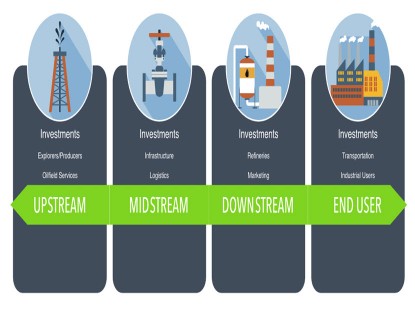A Potential Pipeline of Healthy Cash Flows
The Portfolio Managers share their insights on the macroenvironment driving midstream companies, as well as midstream companies’ advantages in an inflationary environment, valuations, and payout levels.
-
 Ben Cook, CFAPortfolio Manager
Ben Cook, CFAPortfolio Manager -
 L. Joshua Wein, CAIAPortfolio Manager
L. Joshua Wein, CAIAPortfolio Manager
What has been driving midstream companies in recent months?
Over the past year, there has been a higher global demand for oil and natural gas, benefitting midstream pipeline companies that transport, store, and process oil and natural gas. In addition, the current Russian invasion of Ukraine underscores the need for reliable U.S. energy as Europe reduces its reliance on Russian fuel supplies.
The rebound in U.S. activity levels has created a rise in hydrocarbon throughput volumes through many midstream companies’ pipelines, elevating free cash flow. With rising cash levels, midstream companies have reduced their debt burdens, increased
share repurchases, and amplified distribution and dividend payouts.
What are the payout levels for midstream companies?
We believe dividend payout levels remain attractive. Average yields across the Midstream MLP subgroup and C-Corps were currently at roughly 8% and 6%, respectively.1 Yet payout coverage levels remain healthy, with a cash payout coverage of roughly 1.9x—companies have roughly twice the cash available for payouts than what is currently being paid. In our view, this provides the strong potential for rising payout growth going forward.
What advantages do midstream equities possess in an inflationary environment?
Some of the pipelines operated by midstream companies that transport oil and natural gas liquids are regulated by the Federal Energy Regulatory Commission (FERC). These FERC-regulated pipelines often have an inflation adjuster component added to the rate these companies are allowed to charge their customers. Over time, that rate can increase by a percentage equal to the change in the producer price index for finished goods (PPI-FG). This mechanism offsets increasing costs occurring in other parts of their business.
Also, within the liquids-gathering infrastructure, on a contractual basis, some midstream companies will accept a portion of the liquids stream as a component of their payment for handling the volumes. By taking possession of the product, they can generate an uplift through the mechanism of the higher liquids price, which they then sell to the marketplace.
Would you please discuss valuations?
On a free cash yield basis, midstream companies look attractive. Free cash yield considers cash availability beyond capital expenditures and dividends and is currently in the mid-teens range.
Midstream companies also appear inexpensive based on consensus estimates. As of February 2022, sector MLP (master limited partnership) valuations were trading at 8.1x on a 2023 EV/EBITDA basis. That figure is 14% below its 5-year average of 9.5x.
On a 2023 EV/EBITDA basis as of February 2022, C-Corp midstream companies were trading at 10x, which is 7% below the 5-year average.
We believe the combination of solid sector fundamentals, the prospect for rising interest rates, and these attractive valuations, offer strong appeal for midstream companies on both an absolute and relative basis when compared to other sectors.
- In this article:
- Energy
- Midstream Fund
You might also like
-
 Investment Idea
Investment IdeaDefining the Energy "Value Chain"
 Ben Cook, CFAPortfolio ManagerRead the Investment Idea
Ben Cook, CFAPortfolio ManagerRead the Investment IdeaEnergy is a large and complex sector. The sector’s broad sub-industries can be divided into a “value chain,” each segment of which has different characteristics and offers different investment opportunities.
-
 Portfolio Perspective
Portfolio Perspective
Midstream FundWhat’s Driving Midstream Company Performance?
 Ben Cook, CFAPortfolio Manager
Ben Cook, CFAPortfolio Manager L. Joshua Wein, CAIAPortfolio ManagerRead the Commentary
L. Joshua Wein, CAIAPortfolio ManagerRead the CommentaryThe Portfolio Managers Ben Cook, CFA and Josh Wein share their insights on midstream companies’ strong performance over the past year, their shareholder-friendly capital allocation approach and current valuations.
-
 Portfolio Perspective
Portfolio Perspective
Energy Transition FundEnergy Transition Outlook 2025 – Key Investment Opportunities
 Ben Cook, CFAPortfolio Manager
Ben Cook, CFAPortfolio Manager L. Joshua Wein, CAIAPortfolio ManagerRead the Commentary
L. Joshua Wein, CAIAPortfolio ManagerRead the CommentaryThe U.S. continues to be an engine of growth when it comes to energy production. The following commentary summarizes the 2024 market and what to expect in the new year.
